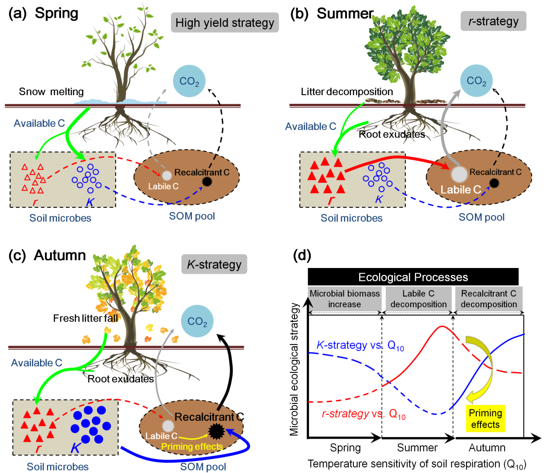The Underlying Microbial Mechanisms Driving the Temperature Sensitivity of Soil Respiration Varied by Season
The intensity of soil respiration increases with temperature on a global scale. Temperature sensitivity of soil respiration, usually termed as Q10, is defined as the increase in CO2 efflux for a 10°C increase in temperature. In many traditional ecosystem models, Q10 was regarded as a constant. But more and more studies have shown that the observed Q10 values varied greatly in time and space, and that it is of great value to quantify the temporal-spatial pattern of Q10, which involves in the accurate prediction of ecosystem carbon emissions.
Prof. LI Hui and her colleagues from the Institute of Applied Ecology of the Chinese Academy of Sciences recently revealed latitudinal and seasonal variations in temperature sensitivity of soil respiration (Q10) by cultivating the soil samples collected from northern, central and southern regions of the broad-leaved Korean pine mixed forest (BKPF) in China.
The researchers found that the latitudinal pattern of Q10 was season-dependent. In spring, the Q10 values got higher along the north-to-south gradient, driven by the increasing temperature and the decreasing carbon availability. In summer, Q10 remained relatively stable across the latitudinal gradient. In autumn, Q10 values were still higher in the warmer regions of BKPF, as is the case in spring. And there was a positive linkage between Q10 and the activity of microbial K-strategists in the late growing season.
The researchers found a uniform seasonality pattern of Q10 in both southern and central regions of BKPF, with higher Q10 values observed in spring and autumn and lower values recorded in summer. However, the seasonality pattern of Q10 was not found in the northern regions of BKPF and this could be attributed to "the dominance of conifers" there, according to the researchers.
This study expanded our understanding of the temporal-spatial variation of Q10 and of its driving mechanisms (e.g., carbon quality, carbon availability and microbial ecological functions), which provided new theories and data for subsequent research about climate warming and ecosystem carbon balance.
This study has been published in Soil Biology & Biochemistry, entitled "Linkages between the temperature sensitivity of soil respiration and microbial life strategy are dependent on sampling season", and it was funded by the Natural Science Foundation of China and the Sino-Russian International Cooperation Program.

Fig. 1 Locations of the sampling sites (a) and the latitudinal and seasonal changes in temperature sensitivity of soil respiration (Q10) across temperate mixed forests (b). To determine the seasonal effects or the site effects on Q10, one-way ANOVA and Duncan’s multiple-range test were performed. Capital letters indicate significant differences among season within sites, and lower letters indicate significant differences among sites within season (p < 0.05). N, northern site; M, middle site; S, southern site (Image by LI Hui).

Fig. 2 Factors affecting temperature sensitivity of soil respiration (Q10) across latitudinal gradient in spring (a), summer (b), and autumn (c), as evaluated by the structural equation model (SEM). The climate factor is represented by the mean temperature of the sampling month (MMT). We used principal component analysis (PCA) to create multivariate indexes for microbial r-/K- strategy ratio with variables of bacterial copiotrophs/oligotrophs ratio (BC/O), fungal copiotrophs/oligotrophs ratio (FC/O), and labile/recalcitrant C degradation genes ratio (L/R genes). The first principal components (PC1) of site scores were used in the SEM analysis (Image by LI Hui).

Fig. 3 Concept of microbial mechanisms driving the latitudinal changes of Q10 across the growing season. (a) In spring, soil microbes are under “famine” conditions and adopt a “high yield strategy”, which invests energy in building microbial biomass rather than in respiration. (b) In summer, the readily available organic substances from root exudates and decomposing litter stimulate the r-strategy features of microbial community, which contributes to the CO2 production and increase its temperature sensitivity (Q10). (c) In autumn, the amounts of dissolved C and N resources are in excess, and the utilization of fresh litterfall by r-strategists activates the mobilization of recalcitrant old carbon, which is mainly performed by K-strategists. Thus, microbial respiration and its temperature sensitivity (Q10) are closely linked with K-strategy features of microbial community. (d) Dynamics of the relationships between Q10 and microbial life strategies during the growing season (Image by LI Hui).
Contact
YUE Qian
Institute of Applied Ecology, Chinese Academy of Sciences
Tel: 86-24-83970324
E-mail: yueqian@iae.ac.cn
Web: http://english.iae.cas.cn



